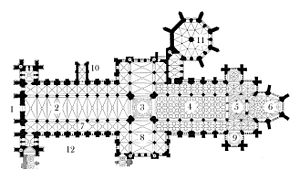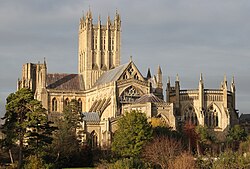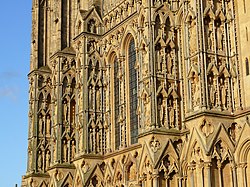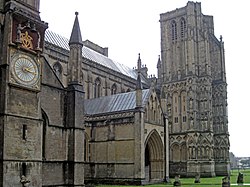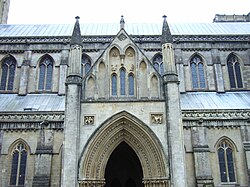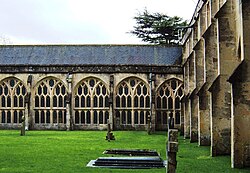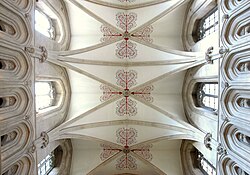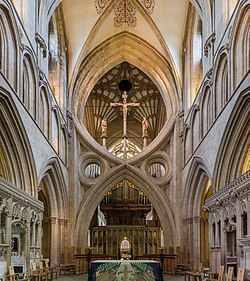Wells Cathedral
| Wells Cathedral | |
|
Cathedral Church of St Andrew, Wells | |
|---|---|
|
Wells, Somerset | |
| Status: | Cathedral |
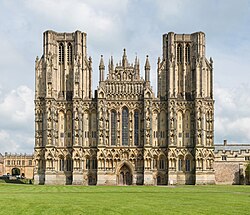 The West Front of Wells Cathedral | |
| Church of England | |
| Diocese of Bath and Wells | |
| Location | |
| Grid reference: | ST551458 |
| Location: | 51°12’37"N, 2°38’37"W |
| History | |
| Built 1176–1490 | |
| Information | |
| Website: | wellscathedral.org.uk |
Wells Cathedral, which dominates the little city of Wells in Somerset, is the seat of the Bishop of Bath and Wells and cathedral of the Diocese of Bath and Wells. It is one of the grandest of the cathedrals of the Church of England.
The present building dates from 1175 to 1490, an earlier church having been built on the site in 705. It is moderately sized among the mediæval cathedrals, falling between those of massive proportion, such as Lincoln and York, and the much smaller cathedrals of Oxford and Carlisle. With its broad west front and large central tower, it is the dominant feature of its small cathedral city and a landmark in the Somerset countryside. Wells has been variously described as "unquestionably one of the most beautiful"[1] and as "the most poetic" of British cathedrals.
The architecture of the cathedral presents a harmonious whole which is entirely Gothic and mostly in a single style, the Early English Gothic of the late 12th and early 13th centuries. In this Wells differs from most other mediæval cathedrals, which have parts in the earlier Romanesque architectural style introduced to Britain by the Normans in the 11th century.
A unique feature are the scissor arches supporting the tower at the crossing.
Contents
Style
Work on the cathedral commenced in about 1175 at the eastern end with the building of the choir. The historian John Harvey considers this to be the first truly Gothic structure in Europe, having broken from the last constraints of Romanesque.[2] The stonework of its pointed arcades and fluted piers is enriched by the complexity of the pronounced mouldings and vitality of the carved capitals in a foliate style known as "stiff leaf".[3] The exterior has an Early English façade displaying more than three hundred sculpted figures,[4] and described by Harvey as "the supreme triumph of the combined plastic arts in England".[5] The eastern end retains much ancient stained glass, which is rare.[4]
Unlike the many cathedrals of monastic foundation, Wells has an exceptional number of surviving secular buildings associated with its chapter of secular canons, such as the Bishop's Palace and the Vicars' Close, a residential street which has remained intact from the 15th century.[6]
The cathedral is a Grade I listed building.[7][8]
History
Early years
The earliest remains of a building on the site are of a late Roman mausoleum, identified during excavations in 1980.[8][9] An abbey church was built in Wells in 705 by Aldhelm, first bishop of the newly established Diocese of Sherborne during the reign of King Ine of Wessex.[10][11] It was dedicated to St Andrew and stood at the present site of the cathedral's cloisters, where some excavated remains can be seen. The baptismal font in the cathedral's south transept is from this church and is the oldest part of the present building.[12][13] In 766 Cynewulf King of Wessex, signed a charter endowing the church with eleven hides of land. In 909 the seat of the diocese was moved from Sherborne to Wells.[8]
The first Bishop of Wells was Athelm (909), who crowned King Æthelstan. Athelm and his nephew Dunstan both became Archbishops of Canterbury.[10] During this period a choir of boys was established to sing the liturgy. Wells Cathedral School, which was established to educate these choir boys, dates its foundation to this point.[14] There is however some controversy over this.
Following the Norman Conquest, Bishop John de Villula moved the seat of the bishop from Wells to Bath in 1090. The church at Wells, no longer a cathedral, had a college of secular clergy.
Seat of the bishop
The cathedral is thought to have been conceived and commenced in about 1175 by Bishop Reginald Fitz Jocelin, who died in 1191. Although it is clear from its size that, from the outset, the church was planned to be the cathedral of the diocese, the seat of the bishop moved between Wells and the abbeys of Glastonbury and Bath, before settling at Wells. In 1197 Bishop Reginald's successor, Bishop Savaric FitzGeldewin, officially moved his seat to Glastonbury Abbey. The title of Bishop of Bath and Glastonbury was used until the Glastonbury claim was abandoned in 1219.[15]
Bishop Savaric's successor, Jocelin of Wells, again moved the bishop's seat to Bath Abbey, with the title Bishop of Bath. Jocelin was a brother of Bishop Hugh II of Lincoln[16] and was present at the signing of the Magna Carta. Bishop Jocelin continued the building campaign begun by Bishop Reginald and was responsible for the Bishop's Palace, the choristers' school, a grammar school, a hospital for travellers and a chapel. He also had a manor house built at Wookey, near Wells.[17] Jocelin saw the church dedicated in 1239 but, despite much lobbying of the pope by Jocelin's representatives in Rome, did not live to see cathedral status granted. The delay may have been a result of inaction by Pandulf Masca, a Roman ecclesiastical politician, papal legate to England and Bishop of Norwich, who was asked by the pope to investigate the situation but did not respond.[18] Jocelin died at Wells on 19 November 1242 and was buried in the choir of the cathedral;[16][17][19] the memorial brass on his tomb is one of the earliest brasses in England.[17] Following his death the monks of Bath unsuccessfully attempted to regain authority over Wells.[20]
In 1245 the ongoing dispute over the title of the bishop was resolved by a ruling of Pope Innocent IV who established the title as the "Bishop of Bath and Wells", as it has remained until this day, with Wells as the principal seat of the bishop.[21] Since the 11th century the church has had a chapter of secular clergy, like the cathedrals of Chichester, Hereford, Lincoln and York. The chapter was endowed with twenty-two prebends (lands from which finance was drawn) and a provost to manage them. On acquiring cathedral status, in common with other such cathedrals, it had four chief clergy, the dean, precentor, chancellor and sacristan, who were responsible for the spiritual and material care of the cathedral.[22]
Building the cathedral
The building programme, begun by Bishop Reginald Fitz Jocelin in the 12th century, continued under Jocelin of Wells, who was a canon from 1200, then bishop from 1206. Adam Locke was master mason from about 1192 until 1230.[23] It was designed in the new style with pointed arches, later known as Gothic, and which was introduced at about the same time at Canterbury Cathedral.[24] Work was halted between 1209 and 1213 when King John was excommunicated and Bishop Jocelin was in exile,[25] but the main parts of the church were complete by the time of the dedication by Bishop Jocelin in 1239.[26]
By the time the cathedral, including the chapter house, was finished in 1306,[27] it was already too small for the developing liturgy, and unable to accommodate increasingly grand processions of clergy. Bishop John Droxford initiated another phase of building under master mason Thomas of Whitney,[27] during which the central tower was heightened and an eight-sided Lady chapel, completed by 1326, was added at the east end.[28] Bishop Ralph of Shrewsbury followed, continuing the eastward extension of the choir and retrochoir beyond. He oversaw the building of Vicars' Close and the Vicars' Hall, to give the men who were employed to sing in the choir a secure place to live and dine, away from the town and its temptations.[29] He had an uneasy relationship with the citizens of Wells, partly because of his imposition of taxes,[29] and he surrounded his palace with crenellated walls, a moat and a drawbridge.[30][31]
Bishop John Harewell raised money for the completion of the west front by William Wynford, who was appointed as master mason in 1365. One of the foremost architects of his time, Wynford worked for the king at Windsor, Winchester Cathedral and New College, Oxford.[32] At Wells, he designed the western towers of which north-west was not built until the following century.[33] In the 14th century, the central piers of the crossing were found to be sinking under the weight of the crossing tower which had been damaged by an earthquake the previous century.[34] Strainer arches, sometimes described as scissor arches, were inserted by master mason William Joy to brace and stabilise the piers as a unit.[34][35]
Tudors and Civil War
By the reign of King Henry VII the cathedral building was complete, appearing much as it does today (though the fittings have changed considerably). From 1508 to 1546, the eminent Italian humanist scholar Polydore Vergil was active as the chapter's representative in London. He donated a set of hangings for the choir of the cathedral.[36][37]
While Wells survived the Dissolution of the Monasteries better than those cathedrals of monastic foundation, the abolition of chantries in 1547 resulted in a reduction in the cathedral's income. Mediæval brasses were sold, and a pulpit was placed in the nave for the first time.[38] Between 1551 and 1568, in two periods as dean, William Turner established a herbal garden, which was recreated between 2003 and 2010.[39][40]
Elizabeth I gave the chapter and the Vicars Choral a new charter in 1591, creating a new governing body, consisting of the dean and eight residentiary canons with control over the church estates and authority over its affairs, but no longer entitled to elect the dean (that entitlement thenceforward belonged ultimately to the Crown).[41] The stability brought by the new charter ended with the onset of the Civil War. Local fighting damaged the cathedral's stonework, furniture and windows. The dean, Walter Raleigh, a nephew of the explorer Sir Walter Raleigh, was placed under house arrest after the fall of Bridgwater to the Parliamentarians in 1645, first in the rectory at Chedzoy and then in the deanery at Wells.[42] His jailer, the shoe maker and city constable, David Barrett, caught him writing a letter to his wife. When he refused to surrender it, Barrett ran him through with a sword and he died six weeks later, on 10 October 1646.[43] He was buried in an unmarked grave in the choir before the dean's stall.[44] During the Commonwealth of England under Oliver Cromwell no dean was appointed and the cathedral fell into disrepair. The then bishop went into retirement and some of the clerics were reduced to performing menial tasks.[45]
Restoration to the present
In 1661, after Charles II was restored to the throne, Robert Creighton, who had served as the king's chaplain in exile, was appointed dean and then served as the bishop for two years before his death in 1672.[46] His brass lectern, given in thanksgiving, can be seen in the cathedral. He also donated the great west window of the nave at a cost of £140. Following Creighton's appointment as bishop, Ralph Bathurst, who had been chaplain to the king, president of Trinity College, Oxford and fellow of the Royal Society,[47] became dean. During Bathurst's long tenure the cathedral was restored, however in the Monmouth Rebellion of 1685, Puritan soldiers damaged the west front, tore lead from the roof to make bullets, broke the windows, smashed the organ and furnishings, and for a time stabled their horses in the nave.[48]
Restoration began again under Bishop Thomas Ken who was appointed by the Crown in 1685 and served until 1691. He was one of seven bishops imprisoned for refusing to read King James II's "Declaration of Indulgence", which would have enabled Roman Catholics to resume positions of political power, but popular support led to their acquittal. In apparent contradiction, Ken refused to take the oath of allegiance to William and Mary because James II had not actually abdicated and with others, known as the Nonjurors, was put out of office.[49] His successor, Bishop Kidder, was killed in the Great Storm of 1703 when two chimney stacks on the palace fell on him and his wife, while they were asleep in bed.[50][51]
By the middle of the 19th century, a major restoration programme was needed. Under Dean Goodenough, the monuments were moved to the cloisters and the remaining mediæval paint and whitewash was removed in an operation known as "the great scrape".[52] Anthony Salvin took charge of the extensive restoration of the choir. Wooden galleries that had been installed in the 16th century were removed and the stalls were given stone canopies and placed further back within the line of the arcade. The mediæval stone pulpitum screen was extended in the centre to support a new organ.[53]
The late 20th century saw an extensive restoration programme, particularly of the west front.[54][55] The stained glass is currently under restoration, with a programme underway to conserve the large 14th-century Jesse Tree window at the eastern terminal of the choir.[56][57]
Architecture
Dates, styles and architects
Construction of the cathedral began in about 1175, to the design of an unknown architect. Wells is the first cathedral in England to be, from its foundation, built in the Gothic style. According to art historian John Harvey, it is the first truly Gothic cathedral in the world, its architects having entirely dispensed with all the features that bound the contemporary east end of Canterbury Cathedral and the earlier buildings of France, to the Romanesque.[2] Unlike these churches, Wells has clustered piers rather than columns and has a gallery of identical pointed arches rather than the typically Romanesque form of paired openings. The style, with its simple untraceried lancet arches and convoluted mouldings, is known as Early English Gothic.[58]
From about 1192 to 1230, Adam Lock, the earliest architect at Wells for whom a name is known, continued the transept and nave in the same manner as his predecessor. Lock was also builder of the north porch, to his own design.[23]
The west front was commenced around 1230 by Thomas Norreys, with building and sculpture continuing for thirty years.[23] Its south-west tower was begun 100 years later and constructed between 1365 and 1395, and the north-west tower between 1425 and 1435,[59] both in the Perpendicular Gothic style to the design of William Wynford, [23] who also filled many of the cathedral's early English lancet windows with delicate tracery.[33]
Between 1275 and 1310 the undercroft and chapterhouse were built by unknown architects, the undercroft in the Early English and the chapter house in the Geometric style of Decorated Gothic architecture. In about 1310 work commenced on the Lady Chapel, to the design of Thomas Witney, who also built the central tower from 1315 to 1322 in the Decorated Gothic style.[23] The tower was later braced internally with arches by William Joy.[23] Concurrent with this work, in 1329–45 Joy made alterations and extensions to the choir, joining it to the Lady Chapel with the retrochoir, the latter in the Flowing Decorated style.[23]
Later changes include the Perpendicular vault of the tower and construction of Sugar's Chapel, 1475–1490 by William Smyth. Also, Gothic Revival renovations were made to the choir and pulpitum by Benjamin Ferrey and Anthony Salvin, 1842–57.[23]
Plan
Wells has a total length of 415 feet. In common with Canterbury, Lincoln and Salisbury cathedrals, it has the distinctly British arrangement of two transepts, with the body of the church divided into distinct parts: nave, choir, and retrochoir, beyond which extends the Lady Chapel.[60] The façade is wide, with its towers extending beyond the transepts on either side.[6] There is a large projecting porch on the north side of the nave forming an entry into the cathedral.[61] To the north-east is the large octagonal chapter house, entered from the north choir aisle by a passage and staircase. To the south of the nave is a large cloister, unusual in that the northern range, that adjacent the cathedral, was never built.[62]
Elevation
In section, the cathedral has the usual arrangement of a large church: a central nave with an aisle on each side, separated by two arcades. The elevation is in three stages, arcade, triforium gallery and clerestory.[61] The nave is 67 feet in height, very low compared to the Gothic cathedrals of France.[63] It has a markedly horizontal emphasis, caused by the triforium having a unique form, a series of identical narrow openings, lacking the usual definition of the bays. The triforium is separated from the arcade by a single horizontal string course that runs unbroken the length of the nave. There are no vertical lines linking the three stages, as the shafts supporting the vault rise above the triforium.[61]
West front
The west front of the cathedral is 100 feet high and 147 feet wide, filled with statues of saints, kings and bishops, and according to the architectural historian Alec Clifton-Taylor, it is "one of the great sights of England".[64]
The west front rises in three distinct stages, each clearly defined by a horizontal course. This horizontal emphasis is counteracted by six strongly projecting buttresses defining the cross-sectional divisions of nave, aisles and towers, and are highly decorated, each having canopied niches containing the largest statues on the façade.[64] At the lowest level of the façade is a plain base, contrasting with and stabilising the ornate arcades that rise above it.[64] The base is penetrated by three doors, which are in stark contrast to the often imposing portals of French Gothic cathedrals. The outer two are of domestic proportion and the central door is ornamented only by a central post, quatrefoil and the fine mouldings of the arch.[6]
Above the basement rise two storeys, ornamented with quatrefoils and niches originally holding about four hundred statues, with three hundred surviving until the mid-20th century.[6] Since then, some have been restored or replaced, including the ruined figure of Christ in the gable.
The third stages of the flanking towers were both built in the Perpendicular style of the late 14th century, to the design of William Wynford; that on the north-west was not begun until about 1425.[23] The design maintains the general proportions, and continues the strong projection of the buttresses.
The finished product has been criticised for its lack of pinnacles, and it is probable that the towers were intended to carry spires which were never built.[61] Despite its lack of spires or pinnacles, the architectural historian Banister Fletcher describes it as "the highest development in English Gothic of this type of facade." [65]
The sculptures on the west front at Wells include standing figures, seated figures, half-length angels and narratives in high relief. Many of the figures are life-sized or larger, and together they constitute the finest display of mediæval carving in Britain.[6] The figures and many of the architectural details were painted in bright colours, and the colouring scheme has been deduced from flakes of paint still adhering to some surfaces.[6] The sculptures occupy nine architectural zones stretching horizontally across the entire west front and around the sides and the eastern returns of the towers which extend beyond the aisles. The strongly projecting buttresses have tiers of niches which contain many of the largest figures. Other large figures, including that of Christ, occupy the gable. A single figure stands in one of two later niches high on the northern tower.
In 1851 the archaeologist Charles Robert Cockerell published his analysis of the iconography, numbering the nine sculptural divisions from the lowest to the highest. He defined the theme as "a calendar for unlearned men" illustrating the doctrines and history of the Christian faith, its introduction to Britain and its protection by princes and bishops.[66]
Exterior
The exterior of Wells Cathedral presents a relatively tidy and harmonious appearance since the greater part of the building was executed in a single Earl Gothic style. At Wells, later changes in the Perpendicular style were universally applied, such as filling the lancet windows with simple tracery, the construction of a parapet that encircles the roof, and the addition of pinnacles framing each gable, similar to those around the chapter house and on the west front.[61] At the eastern end there is a proliferation of tracery with repeated motifs in the Reticulated style, a stage between Geometric and Flowing Decorated tracery.[67]
The central tower appears to date from the early 13th century. It was substantially reconstructed in the early 14th century during the remodelling of the east end, necessitating the internal bracing of the piers a decade or so later. In the 14th century the tower was given a timber and lead spire which burnt down in 1439. The exterior was then reworked in the Perpendicular style and given the present parapet and pinnacles.[26] Alec Clifton-Taylor describes it as "outstanding even in Somerset, a county famed for the splendour of its church towers".[4]
The north porch is described by art historian Nikolaus Pevsner as "sumptuously decorated", and intended to be the main entrance.[68] Externally it is simple and rectangular with plain side walls. The entrance is a steeply arched portal framed by rich mouldings of eight shafts with stiff-leaf capitals each encircled by an annular moulding at middle height. Those on the left are figurative, containing images representing the martyrdom of St Edmund the Martyr.[61] The walls are lined with deep niches framed by narrow shafts with capitals and annulets like those of the portal.
Interior
The vault of the nave rises steeply in a simple quadripartite form, in harmony with the nave arcade.[61] The eastern end of the choir was extended and the whole upper part elaborated in the second quarter of the 14th century by William Joy.[23] The vault has a multiplicity of ribs in a net-like form, which is very different from that of the nave, and is perhaps a recreation in stone of a local type of compartmented wooden roof of which examples remain from the 15th century, including those at St Cuthbert's Church, Wells.[69] The vaults of the aisles of the choir also have a unique pattern.[61]
Until the early 14th century the interior of the cathedral was in a unified style, but it was to undergo two significant changes, to the tower and to the eastern end. Between 1315 and 1322 the central tower was heightened and topped by a spire which caused the piers that supported it to show signs of stress.
In 1338 the mason William Joy employed an unorthodox solution by inserting low arches topped by inverted arches of similar dimensions, forming scissors-like structures. These arches brace the piers of the crossing on three sides, while the easternmost side is braced by a choir screen.[70] The bracing arches are known as the "St Andrew's Cross arches" as a reference to the patronal saint of the cathedral and have been described by Wim Swaan as "brutally massive" and intrusive in an otherwise restrained interior.[6]
Chapter House
The chapter house was begun in the late 13th century and built in two stages, completed about 1310. It is a two-storeyed structure with the main chamber raised on an undercroft. It is entered from a staircase which divides and turns, one branch leading through the upper storey of Chain Gate to Vicars' Close. The Decorated interior is described by Alec Clifton-Taylor as "architecturally the most beautiful in England".[67] It is octagonal, with its ribbed vault supported on a central column. The column is surrounded by shafts of Purbeck Marble, rising to a single continuous rippling foliate capital of stylised oak leaves and acorns, quite different in character to the Early English stiff-leaf foliage. Above the moulding spring thirty-two ribs of strong profile giving an effect generally likened to "a great palm tree".[67] The windows are large with Geometric Decorated tracery that is beginning to show an elongation of form, and ogees in the lesser lights that are characteristic of Flowing Decorated tracery. The tracery lights still contain ancient glass.[67] Beneath the windows are fifty-one stalls, the canopies of which are enlivened by carvings including many heads carved in a light-hearted manner.[67]
Bells
The bells at Wells Cathedral are the heaviest ring of ten bells in the world,[71] the tenor bell (the 10th and largest), known as Harewell, weighing Error: mismatched units.[72] They are hung for full circle ringing. These bells are now hung in the south west tower, although some were originally hung in the central tower.[73]
Library
The library is above the eastern cloister, and was built between 1430 and 1508.[23] The library's collection is in three parts: early documents, housed in the Muniment Room; the collection predating 1800, housed in the Chained Library; and the post-1800 collection, housed in the Reading Room.[74] The chapter's earlier collection was destroyed during the Reformation, so the present library consists chiefly of early printed books, rather than mediæval manuscripts.[74] The earlier books, in the Chained Library, number 2,800 volumes and give an indication of the variety of interests of the members of the cathedral chapter from the Reformation until 1800. The focus of the collection is predominantly theology but there are volumes on science, medicine, exploration, and languages. Books of particular interest include Pliny's Natural History printed in 1472, an Atlas of the World by Abraham Ortelius, printed in 1606 and a set of the works of Aristotle that once belonged to Erasmus.[74] The library is open to the public at appointed times during summer and has a small exhibition of documents and books.[74]
Three early registers of the dean and chapter of Wells – the Liber Albus I (White Book; R I), Liber Albus II (R III) and Liber Ruber (Red Book; R II, section i) – were edited by W. H. B. Bird for the Historical Manuscripts Commissioners and published in 1907.[75] The books comprise, with some repetition, a cartulary of possessions of the cathedral, with grants of land dating back as early as the 8th century, well before the development of hereditary surnames in England; they also comprise acts of the dean and chapter, and surveys of their estates, mostly in Somerset.[76]
Precincts
The cathedral is situated adjacent to a large lawned area, Cathedral Green, which is approached by three ancient gateways, Brown's Gatehouse, Penniless Porch and Chain Gate. On Cathedral Green is the 12th-century Old Deanery, largely rebuilt in the late 15th century by Dean Gunthorpe and remodelled by Dean Bathurst in the late 17th century. It is no longer the residence of the dean, and instead serves as offices for the diocese.[77]
To the south of the cathedral is the moated Bishop's Palace, begun around 1210 by Bishop Jocelin of Wells but dating mostly from the 1230s. In the 15th century Bishop Beckington added the north wing, which is now the bishop's residence.[77][78] It was restored and extended by Benjamin Ferrey between 1846 and 1854.[79]
To the north of the cathedral and connected to it by the Chain Gate is Vicars' Close, a street planned in the 14th century and claimed to be the oldest purely residential street in Europe with all but one of its original buildings surviving intact.[80][81] Buildings in Vicars' Close include the Vicars Hall and gateway at the south end, and the Vicars Chapel and Library at the north end.[82][83]
The Liberty of St Andrew was the historic liberty and parish[84] that encompassed the cathedral and surrounding lands closely associated with it.
Outside links
| ("Wikimedia Commons" has material about Wells Cathedral) |
References
- ↑ Oggins, Robin. Cathedrals, p. 42 (Sterling Publishing Company 1996).
- ↑ 2.0 2.1 Harvey 1987, p. 19.
- ↑ Clifton-Taylor 1967, p. 77.
- ↑ 4.0 4.1 4.2 Clifton-Taylor 1967, p. 274.
- ↑ Harvey 1961, p. 63.
- ↑ 6.0 6.1 6.2 6.3 6.4 6.5 6.6 Swaan 1984, pp. 188–196.
- ↑ National Heritage List 1382901: Cathedral Church of St Andrew, Chapter House and Cloisters
- ↑ 8.0 8.1 8.2 National Monuments Record: No. 196971 – Wells Cathedral
- ↑ Adkins 1992, pp. 118–119.
- ↑ 10.0 10.1 "The History and Architecture of Wells Cathedral in Somerset, Part 1". Britannia. http://www.britannia.com/history/somerset/churches/wellscath.html. Retrieved 11 July 2013.
- ↑ Malden 1947, p. 27.
- ↑ Pepin 2004, p. 141.
- ↑ "Chronological History". Wells Cathedral. http://www.wellscathedral.org.uk/history/timeline/. Retrieved 15 February 2014.
- ↑ "History". Wells Cathedral School. http://www.wellscathedralschool.org/wells/index.php/history. Retrieved 2 February 2013.
- ↑ Brooke 1976, pp. 184–185.
- ↑ 16.0 16.1 Bishops - Fasti Ecclesiae Anglicanae 1066–1300: volume 7: Bath and Wells}}
- ↑ 17.0 17.1 17.2 Dunning, Robert. "Wells, Jocelin of (d. 1242)". Oxford Dictionary of National Biography. http://www.oxforddnb.com/view/article/14831. Retrieved 15 November 2007. (subscription or UK public library membership required)
- ↑ Colchester 1987, p. 15.
- ↑ Fryde 1986, p. 228.
- ↑ Robinson 1916, p. 161.
- ↑ Dunning 2001, p. 41.
- ↑ Podmore, Colin (July 2008). "Chapter 5: Old Foundation cathedrals". Dioceses and Episcopal Sees in England. Church of England. http://www.churchofengland.org/media/40671/chapter5.pdf.
- ↑ 23.00 23.01 23.02 23.03 23.04 23.05 23.06 23.07 23.08 23.09 23.10 Harvey 1987, p. 163.
- ↑ Harvey 1987, pp. 57–58.
- ↑ Reid 1963, pp. 40–41.
- ↑ 26.0 26.1 Tatton-Brown & Crook 2002, pp. 74–76.
- ↑ 27.0 27.1 "Wells Cathedral". Sacred destinations. http://www.sacred-destinations.com/england/wells-cathedral. Retrieved 3 February 2013.
- ↑ "Wells Cathedral". Isle of Albion. http://www.isleofalbion.co.uk/sites/102/wells_cathedral.php. Retrieved 3 February 2013.
- ↑ 29.0 29.1 "Local history". Wells UK. Archived from the original on 24 December 2007. http://web.archive.org/web/20071224145315/http://www.wells-uk.com/local_history.php. Retrieved 10 February 2008.
- ↑ Coulson, Charles. "Hierarchism in Conventual Crenellation" (PDF). Mediæval Archaeology (Society for Mediæval Archaeology) 26: pp. 69–100. http://archaeologydataservice.ac.uk/catalogue/adsdata/arch-769-1/dissemination/pdf/vol26/26_069_100.pdf. Retrieved 24 February 2013.
- ↑ "Bishop's Palace Timeline" (PDF). Bishops Palace. http://www.bishopspalace.org.uk/attachments/The%20Palace%20Rooms.pdf. Retrieved 24 February 2013.
- ↑ Harvey 1987, p. 352.
- ↑ 33.0 33.1 Wade 1926, p. 257.
- ↑ 34.0 34.1 "The cathedrals of Britain". BBC. http://www.bbc.co.uk/history/british/architecture_cathedral_01.shtml. Retrieved 4 September 2011.
- ↑ "Wells Cathedral". Timeref. http://timeref.com/hpl285.htm. Retrieved 10 February 2008.
- ↑ Hay 1952, pp. 8–20.
- ↑ Harris, Oliver (2006). "Polydore Vergil's hangings in the quire of Wells Cathedral". Somerset Archaeology and Local History 149: 71–77.
- ↑ "The Reformation". Wells Cathedral. http://www.wellscathedral.org.uk/history/timeline/the-reformation/. Retrieved 2 September 2011.
- ↑ The Diocese of Bath and Wells (2013). "The Old Deanery Garden, Wells". olddeanerygarden.org.uk. http://www.olddeanerygarden.org.uk/index.php. Retrieved 23 November 2013.
- ↑ Adler, Mark (May 2010). "Haunt of ancient peace". Mendip Times. pp. 36–37.
- ↑ Colleges: The cathedral of Wells - A History of the County of Somerset: Volume 2
- ↑ Marchant, E.C.. "Ralegh, Walter (1586–1646) Dean of Wells". Oxford Dictionary of National Biography. http://www.oxforddnb.com/view/article/23040. Retrieved 15 November 2007. (subscription or UK public library membership required)
- ↑ "Hollywood parodies real life drama in Wells". BBC. 24 October 2010. http://www.bbc.co.uk/somerset/content/articles/2007/10/24/elizabeth_feature.shtml. Retrieved 10 February 2008.
- ↑ Template:DNB
- ↑ "Destruction and Disaster". Wells Cathedral. http://www.wellscathedral.org.uk/history/timeline/destruction-and-disaster/. Retrieved 2 September 2011.
- ↑ Lehmberg 1996, p. 55.
- ↑ Hopkins 2005, p. 161.
- ↑ "The Monmouth rebellion and the bloody assize". Somerset County Council. http://www.somerset.gov.uk/archives/ASH/Monmouthreb.htm. Retrieved 11 February 2008.
- ↑ Ollard, S.L. (1912). "The Nonjurors". A Dictionary of English Church History. Mowbray and Co.. http://anglicanhistory.org/nonjurors/ollard_crosse1912.html.
- ↑ "Richard Kidder (1633–1703), Bishop of Bath and Wells (1691–1703)". BBC. http://www.bbc.co.uk/arts/yourpaintings/paintings/richard-kidder-16331703-bishop-of-bath-and-wells-16911703-39388. Retrieved 2 September 2011.
- ↑ Cassan, Stephen Hyde (1829). Lives of the Bishops of Bath. C and J Rivington. p. 163. http://books.google.com/?id=OJgAAAAAcAAJ&pg=RA1-PA163.
- ↑ "Victorian Restorations". Wells Cathedral. http://www.wellscathedral.org.uk/history/timeline/249-2/. Retrieved 2 September 2011.
- ↑ Colchester 1987, pp. 126–7.
- ↑ Hatton 1999, pp. 218–230.
- ↑ "The West Front Restoration". Wells Cathedral. http://www.wellscathedral.org.uk/history/heritage-conservation/the-west-front-restoration/. Retrieved 24 February 2013.
- ↑ "The Jesse Window Project – An Update (November 2012)". Wells Cathedral. http://www.wellscathedral.org.uk/history/heritage-conservation/the-jesse-window-project/. Retrieved 24 February 2013.
- ↑ "Conservation of 'Tree of Jesse' Window at Wells Cathedral". Vidimus (43). September 2010. http://vidimus.org/issues/issue-43/news/. Retrieved 24 February 2013.
- ↑ Fletcher 1961, pp. 189–90.
- ↑ Dunning, Robert (2007). Somerset Churches and Chapels: Building Repair and Restoration. Halsgrove. p. 41. ISBN 978-1841145921.
- ↑ Swaan 1984, pp. 173–174.
- ↑ 61.0 61.1 61.2 61.3 61.4 61.5 61.6 61.7 Pevsner 1958, pp. 278–310.
- ↑ Clifton-Taylor 1967, p. 136.
- ↑ Clifton-Taylor 1967, pp. 74–79.
- ↑ 64.0 64.1 64.2 Clifton-Taylor 1967, p. 78.
- ↑ Fletcher 1961, p. 421.
- ↑ Cockerell 1851, p. 26.
- ↑ 67.0 67.1 67.2 67.3 67.4 Clifton-Taylor 1967, pp. 156–158.
- ↑ Nikolaus Pevsner: Pevsner Architectural Guides
- ↑ Swaan 1984, p. 193.
- ↑ Heyman, Jacques (November 2001). "Why ancient cathedrals stand up: The structural design of masonry" (PDF). Ingenia (10). http://www.ingenia.org.uk/ingenia/issues/issue10/heyman.pdf. Retrieved 11 February 2008.
- ↑ "Volunteer". Wells Cathedral. http://www.wellscathedral.org.uk/how-you-can-help/volunteering-at-wells/. Retrieved 4 September 2011.
- ↑ Colchester 1987, p. 21.
- ↑ Colchester 1987, p. 52.
- ↑ 74.0 74.1 74.2 74.3 "Library & Archives". Wells Cathedral. http://www.wellscathedral.org.uk/history/library-archives/. Retrieved 2 September 2011.
- ↑ Bird, W.H.B.; Baigent, F.J. (1925). The Black Book of Winchester. Winchester: Warren & Son Limited. p. 241.
- ↑ "Liber Albus I (White Book; R I), Liber Albus II (R III), and Liber Ruber (Red Book; R II, section i) indexed by surname". Theoriginalrecord.com. http://www.theoriginalrecord.com/database/search/decade/100. Retrieved 11 July 2013.
- ↑ 77.0 77.1 National Heritage List 13316269: The Old Deanery, Wells
- ↑ "Pictures of Bishop's Palace, Wells". Pictures of England. http://www.picturesofengland.com/England/Somerset/Wells/Bishop's_Palace,_Wells. Retrieved 10 November 2007.
- ↑ National Heritage List 1382873: The Bishop's Palace and Bishop's House
- ↑ Leete-Hodge 1985, p. 20.
- ↑ Leete-Hodge 1985, p. 29.
- ↑ National Heritage List 1383201: The Vicars' Chapel
- ↑ National Heritage List 1383202: The Vicars' Hall including number 28, Vicars' Close
- ↑ Vision of Britain Wells St Andrew CP/ParLib
- Adkins, Lesley; Adkins, Roy (1992). A Field Guide to Somerset Archaeology. Dovecote Press. ISBN 978-0-946159-94-9.
- Bedford, Ronald (2007). Early Modern English Lives: Autobiography and Self-representation 1500–1660. Ashgate. ISBN 978-0-7546-5295-3. http://books.google.com/?id=lVGe6OAP7IMC&pg=PA23&lpg=PA23&dq=Wells+Cathedral+quarter+jacks+knights+in+armour#v=onepage&q=Wells%20Cathedral%20quarter%20jacks%20knights%20in%20armour&f=false.
- Brooke, C. N. L. (1976). Church and Government in the Middle Ages. Cambridge University Press. ISBN 978-0-521-21172-7. http://books.google.com/?id=QtA8AAAAIAAJ&pg=PA184&lpg=PA184&dq=Bishop+of+Bath+and+Glastonbury+1219#v=onepage&q=Bishop%20of%20Bath%20and%20Glastonbury%201219&f=false.
- Cave, Charles J. P. (1948). Roof Bosses in Mediæval Churches: An Aspect of Gothic Sculpture. Cambridge University Press. OCLC 716449181.
- Clarke, Alfred Alexander (1896). Monograph on the cathedral church of Wells. Wells : Arthur G. Young ; London : W. H. Smith & Sons. https://archive.org/details/monographoncathe00clarrich.
- Clifton-Taylor, Alec (1967). The Cathedrals of England. Thames & Hudson. ISBN 978-0-500-18070-9.
- Cockerell, Charles Robert (1851). Iconography of the West Front of Wells Cathedral. J. H. Parker. https://archive.org/stream/iconographyofwes00cock#page/n13/mode/2up.
- Colchester, L. S. (1987). Wells Cathedral. Unwin Hyman. ISBN 978-0-04-440015-8.
- Cox, J. Charles (2008). English Church Fittings, Furniture and Accessories. Jeremy Mills. ISBN 978-1-905217-93-9. http://books.google.com/?id=E14ADXwreOEC&pg=PA183&dq=Peter+Lightfoot+clock+wells#v=onepage&q=Peter%20Lightfoot%20clock%20wells&f=false.
- Crossley, Frederick Herbert (1962). The English Abbey. Batsford. OCLC 2038195.
- Dunning, Robert (2001). Somerset Monasteries. Tempus. ISBN 978-0-7524-1941-1.
- Fletcher, Banister (1961). A History of Architecture on the Comparative Method (17th ed.). University of London: Athlone Press. OCLC 490562168.
- Fryde, E. B. (1986). Handbook of British Chronology. Royal Historical Society. ISBN 978-0-86193-106-4.
- Hatton, Alf (1999). Cultural Resource Management in Contemporary Society: Perspectives on Managing and Presenting the Past. Routledge. ISBN 978-0-415-11785-2. http://books.google.com/?id=gRqYWcgtgZsC&pg=PA218&lpg=PA218&dq=Wells+Cathedral+west+front+restoration#v=onepage&q=Wells%20Cathedral%20west%20front%20restoration&f=false.
- Harvey, John (1961). English Cathedrals. Batsford. OCLC 2437034.
- Harvey, John (1987). English Mediæval Architects. Sutton Publishing Ltd. ISBN 978-0-86299-452-5.
- Hay, Denys (1952). Polydore Vergil: Renaissance Historian and Man of Letters. Clarendon Press. OCLC 799050.
- Hopkins, Clare (2005). Trinity: 450 Years of an Oxford College Community. Oxford University Press. ISBN 978-0-19-951896-8.
- Leete-Hodge, Lornie (1985). Curiosities of Somerset. Bossiney Books. ISBN 978-0-906456-99-6.
- Lehmberg, Stanford E. (1996). Cathedrals Under Siege: Cathedrals in English Society, 1600–1700. Penn State University Press. ISBN 978-0-271-01494-4.
- Malden, Richard H. (1947). The Story of Wells Cathedral. Raphael Tuck & Sons. OCLC 3138221.
- Matthews, Melvyn (2005). "The Meaning of Wells Cathedral". in Dunning, Robert. Wells Cathedral. Scala Publishers Ltd. ISBN 978-1-85759-370-9.
- Pepin, David (2004). Discovering Cathedrals. Shire Publications. ISBN 978-0-7478-0597-7. http://books.google.com/?id=Qxs7peepspMC&pg=PA141&lpg=PA141&dq=Wells+Cathedral+Transept+oldest+font#v=onepage&q=Wells%20Cathedral%20Transept%20oldest%20font&f=false.
- Nikolaus Pevsner: Pevsner Architectural Guides
- Powicke, Maurice (1961). Handbook of British Chronology. Royal Historical Society. ISBN 978-0-901050-17-5.
- Reid, R. D. (1963). Wells Cathedral. Friends of Wells Cathedral. ISBN 978-0-902321-11-3.
- Remnant, George L.; Anderson, Mary Désirée (1969). A Catalogue of Misericords in Great Britain. Clarendon Press. ISBN 978-0-19-817164-5.
- Robinson, William J. (1916). West Country Churches. 4. Bristol Times and Mirror. OCLC 7393657.
- Smith, John Colin Dinsdale (1975). Picture Book of Misericords of Wells Cathedral. Friends of Wells Cathedral. ISBN 978-0-902321-15-1.
- Swaan, Wim (1984). The Gothic Cathedral. Omega. ISBN 978-0-907853-48-0.
- Tatton-Brown, Tim; Crook, John (2002). The English Cathedral. New Holland Publishers. ISBN 978-1-84330-120-2.
- Wade, G. W.; Wade, J. H. (1926). Somerset. Methuen & Co. OCLC 500472869. https://ia600308.us.archive.org/12/items/somerset12287gut/12287-h/12287-h.htm.
- Warren, Derrick (2005). Curious Somerset. Sutton Publishing. ISBN 978-0-7509-4057-3.
- Further reading
- Ayers, Tim (2004). The Mediæval Stained Glass of Wells Cathedral. Oxford University Press. ISBN 978-0-19-726263-4.
- Colchester, L. S.; Quilter, David Tudway; Quilter, Alan (1985). A History of Wells Cathedral School. Wells Cathedral School. OCLC 70336406.
- Malone, Von Carolyn Marino (2004). Façade as Spectacle: Ritual and Ideology at Wells Cathedral. Brill Publishers. ISBN 978-90-04-13840-7.
| Cathedrals of the Church of England |
|---|
|
Province of York:
Blackburn •
Bradford •
Carlisle •
Chester •
Durham •
Liverpool •
Manchester •
Newcastle upon Tyne •
Peel •
Ripon •
Sheffield •
Southwell •
Wakefield •
York
|





